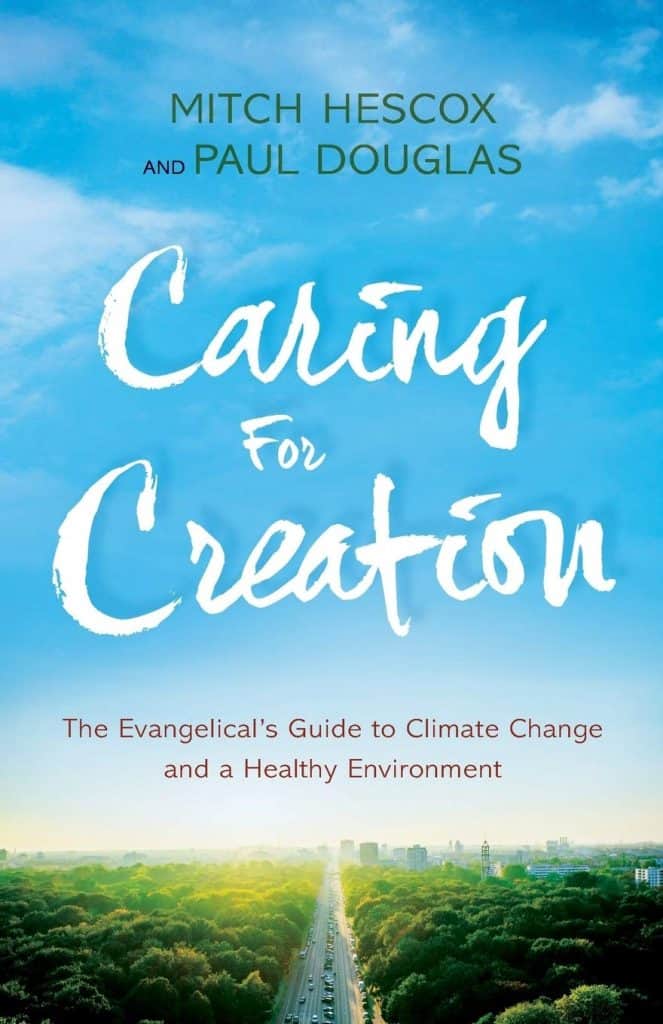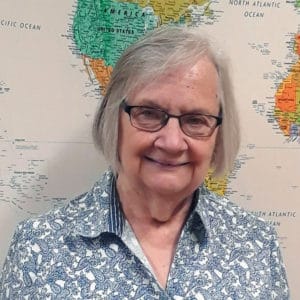Title: Caring for Creation: The Evangelical’s Guide to Climate Change and a Healthy Environment
Authors: Mitch Hescox and Paul Douglas
Publisher: Minneapolis, MN: Bethany House, 2016
Pages: 165 plus end notes
Reviewer: Susan S. Baker
It is often difficult reading about climate change crises as there seem to be so many statistics and technical jargon, but the authors of Caring for Creation: The Evangelical’s Guide to Climate Change and a Healthy Environment broke that mold and wrote a very interesting book on the subject. They intermingled a number of colorful analogies; for example, in the Introduction Douglas wrote, “We are fiddling with the planet’s natural thermostat–poking at the climate system with a long sharp, carbon-tipped stick, and then acting surprised every time the weather bites back.”1 They also broke up the writing with “interest boxes”–some were climate facts from a variety of cities in the U.S. and others were expansions on interesting topics.
Hescox and Douglas had much in common as they both grew up in Pennsylvania and both described themselves as evangelical Christians, Republicans/conservatives, and pro-life from the fetus to the grave. They saw climate change as a subject of science and faith with their primary reason for caring about climate change as following God’s Genesis command to care for His creation.
When Douglas was a child, his family lost their home in Lancaster due to a 1972 hurricane which caused their home to be flooded. Because of this, he took up meteorology. When he viewed the trends for more and more severe weather conditions, he became an entrepreneur and founded a number of businesses to study climate change. He was a scientist with a strong foundation of faith. Hescox grew up in a coal mining family (for a number of generations). The Lord called him from mining to being a pastor and then to become an entrepreneur developing a climate change ministry. He was a pastor with a strong foundation of scientific fact.
Chapter Outlines
The book was separated into eight chapters with the two authors alternating chapters. Chapter 1, by Douglas, was entitled “An Accumulation of ‘Coincidences.’” After referring our weather as having the flu, he explained that “A warming climate isn’t sparking new storms, but it is spiking existing storms and increasing the potential for jaw-dropping, headline-grabbing weather extremes.”2 The idea is that we can see what seems to be a number of coincidences, but as a scientist he recognizes that those “coincidental facts” are really climate trends that will only get worse if ignored. In this chapter he explains the difference between weather and climate as “Climate is what you expect, and weather is what you get.”3 This is an important distinction. We look at our cell phones to see what the weather is going to be that day. We also make fun of the weather person in terms of how often he/she gets the weather wrong. However, climate trends are much more subtle. Douglas completes this chapter by discussing a number of trends: (1) heat waves, droughts, and wildfires, (2) more intense precipitation events (rain and snow), (3) sea level rise, (4) more intense hurricanes, (5) ocean acidification, and (6) more “weather whiplash.”
Chapter 2, by Hescox, was entitled “It’s Not About Polar Bears.” He named this chapter in this way because the polar bear standing on a melting ice floe has become the iconic image of global warming. In this chapter, Hescox brings in their concept of pro-life, that “creation care is truly a matter of life for our kids, the majority of the world’s poor, and even many of the economically disadvantaged in the United States whose homes border some of the most toxic air, foul water, and polluted land.”4 Hescox recognizes that the effects of being exposed toxic chemicals causes what he terms as a “silent pandemic.”5 While Douglas in his first chapter focused on weather, Hescox focuses on such issues as pesticides and how things like that also affect climate as the toxicity finds its way to our oceans. He also makes note of how certain environmental toxins affect development in our young children. At the end of this chapter Hescox speaks about climate refugees, those people groups who are moving due to climate change.
Chapter 3 is entitled “A Healthy Dose of Skepticism.” Many people are skeptical of the whole idea of global warming. We still have cold winters and sometimes those winters are colder with more snowfall than usual. Douglas states, “From the standpoint of a bewildered meteorologist, rather than ‘global warming,’ I prefer the term ‘climate volatility’ resulting in ‘weather disruptions.’”6 Douglas reiterates that the storms, droughts, wildfires, etc. would have happened anyway, but climate change is increasing the strength of these events. As for the title of the chapter, the author states,
Skepticism is a good thing. Scientists are skeptical by nature, and extremely competitive. For thousands of PhD professionals to agree on anything confirms that confidence levels are very high, even if we don’t have every detail and the science isn’t totally settled.7
The author completes the chapter by discussing a number of questions: (1) How do we know recent climate change is man-made? (2) What role has the sun played? (3) Climate is always changing. Why is climate change such a big deal now? (4) If the world is warming, why are some winters and summers still very cold? (5) But I heard there hasn’t been any warming in over fifteen years? (6) How does climate change affect the strength and frequency of floods, droughts, hurricanes, and tornadoes? (7) Meteorologists can’t even get the seven-day outlook right. Why should I trust a fifty-year climate outlook?
Chapter 4, “We Are . . . Easter People” by which Hescox contrasts those who focus on the past (Good Friday—Jesus’ death for our sins) rather than the future (Easter—Jesus’ resurrection bringing new life to us for all eternity). He notes, “It’s almost incredulous that we meet God in creation but haven’t made the connection that caring for creation nurtures our relationship with him.”8 He notes that he thinks that our disregard for the earth is actually a matter of biblical ignorance, a matter of not understanding the biblical mandate to care for God’s creation. He reminds us that there are a number of Christian compassion ministries but he believes we should look beyond compassion to transformation. This comes through discipleship focusing on caring for what (and whom) God cares.
Chapter 5, “A Place for Faith and Science,” explains the importance of science but recognizes that “Science can’t begin to describe the ultimate mystery of life and consciousness, . . . Science is essential–but fundamentally incomplete.”9 As a scientist, Douglas is concerned with facts but knows that science is not just a collection of facts, “It’s a process.”10 He also understands the change in how our government has viewed climate change. “Amazingly, at one point [1970 Clean Air Act] there was almost unanimous, bipartisan support to protect the environment, to keep cleaning up our home. What changed?”11 Besides the need to care for the environment as a whole, the author recognizes that the poor are more adversely affected by the changes. Therefore, we are not only to obey God’s Word as it pertains to the environment, but we are to obey God’s command to care for the least of these, for the poor, for the widow and orphans. This chapter ends with Douglas’ stating, “One can have a deep faith in a Divine Creator and still respect scientists trying to make sense of our world–and our impact on God’s creation.”12
Chapter 6, “Fear Not, for I Am With You,” written by Hescox deals with how much fear people have as they discuss climate change and are moved from their homes through the various effects of climate change. In this chapter the author agrees with his co-author that we have responsibilities toward the poor who are overly affected by climate change. He reminds us that “Fear comes from trusting in ourselves instead of placing trust in the Creator.”13 Not only do we fear the ferocity of our changing weather conditions but we also fear change and the unknown. However, he points out that even though we may fear the costs involved in changing to renewable energy, we have to realize that the full costs (not just financial but insurance, medical, etc.) involved in fossil fuel contaminants make renewable energy equal to or less costly.
Chapter 7, entitled “Silver Buckshot,” begins with another colorful analogy.
There may be no silver bullet yet. But there’s plenty of silver buckshot–hundreds of new technologies and visible, cost-competitive clean energy alternatives, which will gradually, methodically wean us off fossil fuels, employ more Americans, and jump-start a sputtering, rudderless economy.14
One of the technologies talked about in this chapter is solar or wind energy which can be stored for those days when there is no wind or sunshine. He also brings up nuclear energy, which cause many to fear. We tend to remember the nuclear accidents (for example, Three Mile Island), but he notes, “Smaller, safer, more efficient forms of nuclear energy have emerged,”15 which should allay some of our fears. He then discusses steps which will help us move forward: (1) Keep an Open Mind–and Speak Up; (2) Reward efficiency; (3) Support a Price on Carbon Pollution; (4) Acknowledge That This Isn’t a “Liberal Issue;” and (5) Elect Politicians Who Respect Science.16
The final chapter, “We Can Do It–With God’s Help,” starts by stating, “Government can’t do it, businesses can’t go it alone, and we won’t be able to do it by ourselves. But we can do it together.”17 Hescox brings in the concept of stewardship here, especially energy stewardship. This chapter is the most pastoral but also political and economic. It does make clear that all areas of our lives should be subject to our calling to grow to be more like Christ. He ends this chapter by saying, “As God’s children, we are no longer slaves to fear, climate change, or dirty energy. Let’s truly care for creation. It’s a matter of life.”18
Conclusion
This book is loaded with new insights into a seemingly very complex subject. It is a worthwhile read for everyone. The mixture of science and faith permeates every chapter with both perspectives holding importance.
I do have two notes of caution. First, this book was published in 2015 and, especially on the political front, things have changed. For example, it was written, “There are probably numerous factors for this large uptick in conservatives who accept the reality of climate change.”19 Over the last five or six years, things have changed immensely and this is no longer something most conservatives (Republicans) accept. A second caution is that the words Republican and/or conservative are mentioned numerous times throughout the book to the extent that it seems the book is written only, or at least primarily, for conservatives. This is a shame as all people, regardless of political affiliation, can learn a great deal from the book. All those references do not need to be there.
Overall, I believe it is a good book for all Christians to read and, therefore, learn how better to care for God’s creation.
Notes
1 Page 16.
2 Pages 20-21.
3 Page 23.
4 Page 38.
5 Page 40.
6 Page 56.
7 Page 61.
8 Page 72.
9 Page 90.
10 Page 91.
11 Page 93.
12 Page 95.
13 Page 102.
14 Page 126.
15 Page 128.
16 Pages 131-136.
17 Page 141.
16 Page 165.
17 Page 110.

